Top speed 1,060 km/h Engine type Ivchenko-Progress AI-222 | Range 2,546 km Number built 115+ in 2016 | |
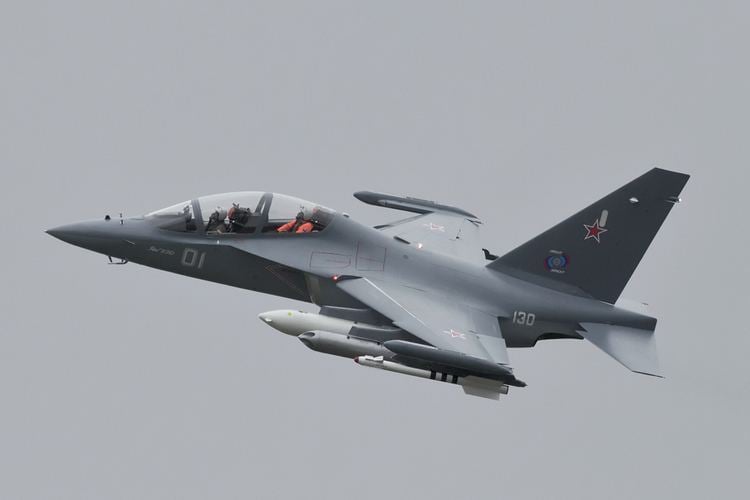 | ||
Unit cost 15,000,000–15,000,000 USD (2010) Manufacturers | ||
Russian air force yakovlev yak 130 awesome r c scale turbine model jet
The Yakovlev Yak-130 (NATO reporting name: Mitten) is a subsonic two-seat advanced trainer aircraft originally developed by Yakovlev and Aermacchi. It has also been marketed as a potential light attack aircraft. Development of the plane began in 1991 and the maiden flight was conducted on 25 April 1996. In 2002, it won a Russian government tender for training aircraft and in 2009 the aircraft entered service with the Russian Air Force. As an advanced training aircraft, the Yak-130 is able to replicate the characteristics of several 4+ generation fighters as well as the fifth-generation Sukhoi PAK FA. It can also perform light-attack and reconnaissance duties, carrying a combat load of 3,000 kg.
Contents
- Russian air force yakovlev yak 130 awesome r c scale turbine model jet
- Huge russia air force yakovlev yak 130 with working artificial horizon turbine r c modell jet
- Development
- Design
- Operational history
- Accidents and incidents
- Orders and deliveries
- Variants
- Operators
- Specifications Yak 130
- References
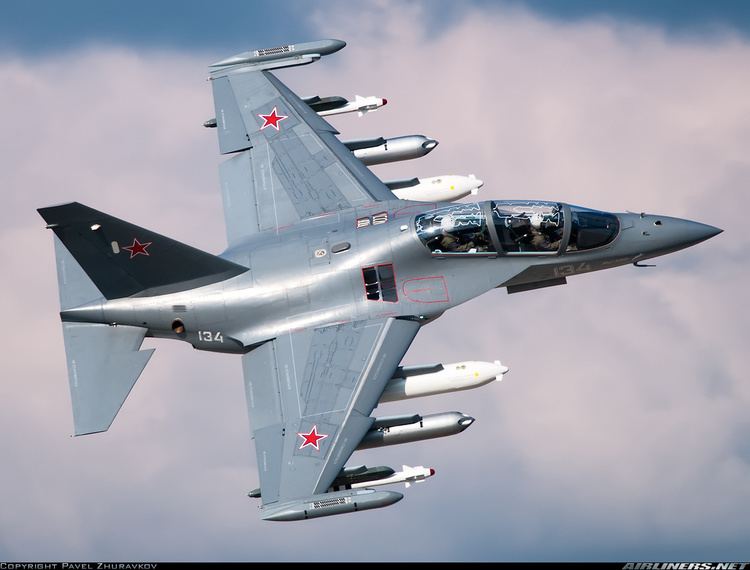
Huge russia air force yakovlev yak 130 with working artificial horizon turbine r c modell jet
Development
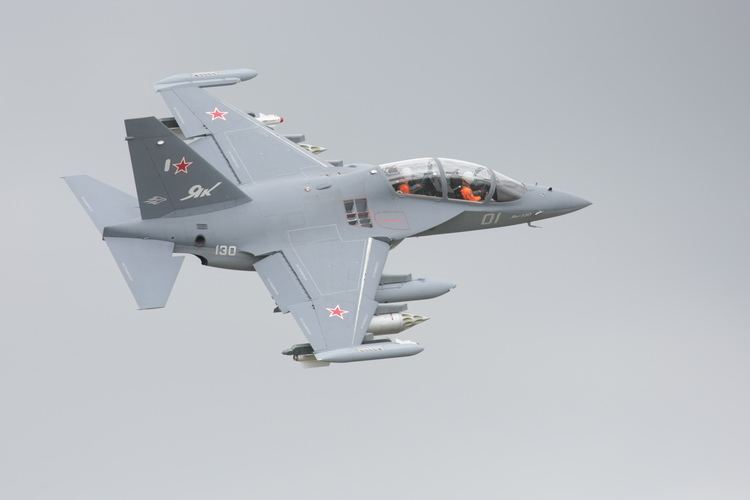
In the early 1990s, the Soviet government asked the industry to develop a new aircraft to replace the Czech-made Aero L-29 Delfín and Aero L-39 Albatros jet trainers. Five design bureaus put forward proposals. Among them were the Sukhoi S-54, Myasishchev M-200, Mikoyan MiG-AT, and Yakovlev Yak-UTS. In 1991, the other proposals were dropped and only the MiG-AT and Yak-UTS remained. The air forces of the newly-independent Russia estimated that its requirement would be about 1,000 aircraft.
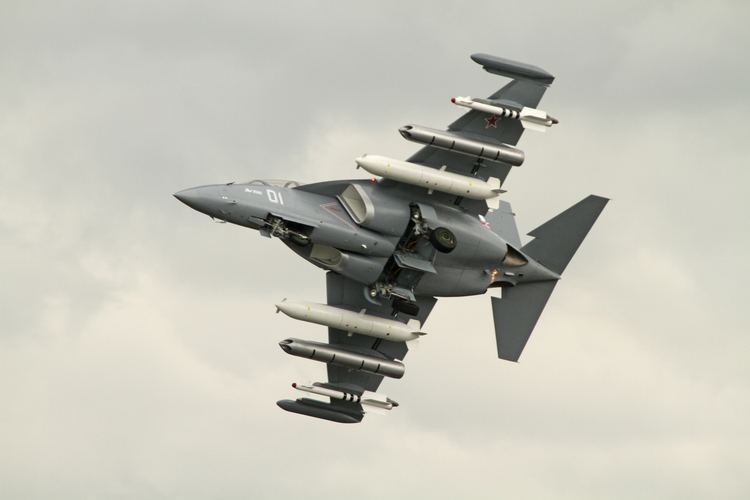
Development of Yak-UTS started in 1991 and the design was completed in September 1993. The same year, Yakovlev entered an agreement with the Italian company Aermacchi to work together on the plane, which now became Yak/AEM-130. In 2000, differences in priorities between the two firms had brought about an end to the partnership, with each developing the aircraft independently. The Italian version was named M-346; Yakovlev received US$77 million for technical documents of the aircraft. Yakovlev would be able to sell the aircraft to countries such those in the Commonwealth of Independent States, India, Slovakia and Algeria. Aermacchi would be able to sell to NATO countries, among others.
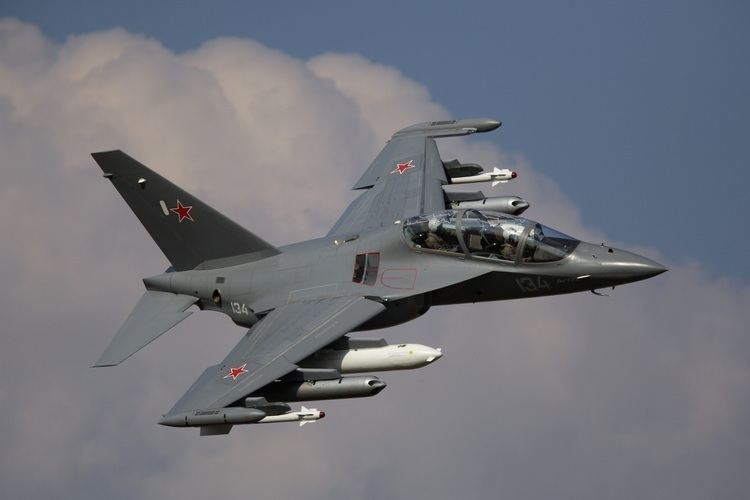
In March 2002, Commander-in-Chief Vladimir Mikhailov said that the Yak-130 and the MiG-AT had been chosen as the Russian Air Force's new trainers. The Yak-130, however, was said to be superior as it could serve the dual role of a trainer and combat jet. Despite that, on 10 April 2002, it was announced that Yak-130 had been chosen as the winner of the tender for trainer aircraft for basic and advanced pilot training, beating the MiG-AT. By then, the Russian Air Force had ordered 10 Yak-130s, and the total cost of research and development, which included the construction and testing of the four pre-production aircraft, had amounted to some $200 million, 84% of which was financed by Yakovlev and the rest by the Russian government. However, it was reported that as much as $500 million had been spent in as early as 1996.

Plans to develop a Light Attack Aircraft based on the Yak-130, came to a halt in the late 2011. Dubbed Yak-131, the aircraft failed to meet "enhanced pilot protection" requirements, put forward by the Russian Air Force. Focus has shifted to a Sukhoi Su-25 replacement, instead. The Light Attack Aircraft was slated to enter service by the year 2020.
Design
Yak-130 is an advanced pilot training aircraft, able to replicate characteristics of Russian 4th and 5th generation fighters. This is possible through the use of open architecture digital avionics compliant with a 1553 Databus, a full digital glass cockpit, four-channel digital Fly-By-Wire System (FBWS) and Instructor controlled and variable FBWS handling characteristics and embedded simulation. The type also has a Head-up display (HUD) and a Helmet-Mounted-Sighting-System (HMSS), with a double GPS/GLONASS receiver updating an Inertial Reference System (IRS) for highly accurate navigation and precision targeting. The developer estimates that the plane can cover up to 80% of the entire pilot flight training program.
In addition to its training role, the aircraft is capable of fulfilling Light Attack and Reconnaissance duties. It can carry a combat load of 3,000 kilograms (6,600 pounds), consisting of various guided and un-guided weapons, auxiliary fuel tanks and electronic pods. According to its chief designer Konstantin Popovich, during a testing phase that ended in December 2009, the plane was tested with "all airborne weapons with a weight of up to 500 kg that are in service in the Russian Air Force". Yak-130 has nine hard points: two wingtip, six under-wing and one under-fuselage.
The aircraft's twin engines are mounted under extended wing roots, which reach as far forward as the windscreen. Two Ivchenko Progress AI-222-25 Full Authority Digital Engine Control (FADEC) produce a combined total of 49 kilonewtons (11,000 pound-force) of thrust. An upgraded, "-28" engine is also on offer, increasing the thrust to 53 kN (12,000 lbf). At a normal Take-Off Weight of 7,250 kg (15,980 lb), a Thrust-to-Weight ratio of 0.70 is achieved with the "-25", or 0.77 with the "-28" engines. This compares with 0.65 for the BAE Systems Hawk 128 and 0.49 for the Aero Vodochody L-159B.
Maximum internal fuel capacity is 1,700 kg (3,700 lb). With two external combat fuel tanks the figure increases to 2,600 kg (5,700 lb). Maximum true airspeed is Mach 0.93 (572 knots), service ceiling is 12,500 metres (41,000 feet) and load factors are from −3 to +9 g. Typical Take-Off speed and distance in a "clean" configuration are 209 km/h (113 kn) and 550 m (1,800 ft), whilst landing figures are 191 km/h (103 kn) and 750 m (2,460 ft), respectively. Cross wind limit is 56 km/h (30 kn).
The Yakovlev Yak-130 is equipped with the FBWS controlled engine intake blanking doors, in order to prevent the aircraft's engines from sustaining Foreign object damage when operating from unpaved runways and grass strips.
The large canopies are sideways hinged.
Combat training suite on the Yak-130 includes simulated and real firing systems with air-to-air and air-to-surface missiles, bomb dropping, gun firing and on-board self-protection systems.
Operational history
Yak-130 prototype completed its maiden flight, registered as RA-431130, on 25 April 1996 at Zhukovsky airfield.
On 30 April 2004, the first pre-series Yak-130, assembled at the Sokol plant in Nizhny Novgorod, performed its maiden flight. The plane was put on display for the first time at the Paris Air Show in June 2005. It was followed by three more pre-series aircraft.
In December 2009, the aircraft completed state trials and was accepted for service in the Russian Air Force.
Accidents and incidents
Orders and deliveries
In 2005, Russian Air Force made its first order for 12 Yak-130s. The Russian Air Force intends to buy at least 72 Yak-130s, enough to equip four training regiments. Commander-in-Chief, Colonel General Aleksandr Zelin, announced on 8 November 2011, that the Russian Defence Ministry was to sign a contract within two weeks with Irkut Corporation for 65 additional aircraft – 55 firm orders plus 10 options. Zelin stated that deliveries were expected to be completed by 2017.
The first serial aircraft was handed to a training center in Lipetsk on 19 February 2010. Once the 2005 contract for 12 Sokol plant-made Yak-130s for the Russian Defence Ministry was fulfilled in June 2011, a decision was made that all subsequent Yak-130 orders, both domestic and export ones, would be handled by the Irkutsk Aviation Plant of the Irkut Corporation. However, the Russian Air Force only took delivery of the first Yak-130 by the Irkutsk in October 2012. "The first batch of Yak-130 combat trainers flew from the Irkut plant to the Borisoglebsk airfield, after an extensive flight testing program", stated Colonel Andrei Bobrun.
In February 2014 Irkut Corporation revealed a contract with the Russian Ministry of Defense (MoD) to supply additional Yakovlev Yak-130 advanced jet trainer aircraft to the National Air Force. According to Irkut president Oleg Demchenko, the company in December signed a contract with the Defense Ministry on the delivery of 12 Yak-130 aircraft to form a new aerobatics team. At the same time, second contract occurred to be signed for 10 more aircraft, for the Russian Naval Aviation.
In April 2012, Irkut Corporation president, Alexey Fedorov claimed that there are "more than ten potential customers".
In November 2012, Sergey Kornev, a representative of the Rosoboronexport (Russia's state intermediary agency for exports/imports of defense-related products) said Malaysia and several other countries are also interested of Yak-130. He was speaking at the China Airshow 2012 in the Chinese city of Zhuhai.
In December 2012, Government of Belarus signed an agreement with Russia to provide four Yak-130 to Belarus by 2015. Belarus has ordered new combat aircraft from Russia, according to the commander of Belarus' Air Force and Air Defense Forces in August 2015. Major General Oleg Dvigalev said the country has signed two contracts for four Russian Yakovlev Yak-130 Mitten trainer/strike aircraft.
Libya put an order for 6 planes. Deliveries to Libya were expected in 2011–2012, but the Libyan National Transitional Council cancelled Libya's order for Yak-130s in September 2011 as part of a review of all existing arms contracts.
Syria has agreed to purchase 36 aircraft, but delivery of these has been postponed by Russia due to the conflict in Syria. In May 2014 Russia announced that it will supply Syria with Yakovlev Yak-130 advanced jet trainer aircraft. Syria was expected to receive nine aircraft by the end of 2014, twelve in 2015 and fifteen in 2016, for overall of 36 airplanes.
In January 2014, Bangladesh ordered 24 Yak-130s. The aircraft are bought with an extended loan from Russia. Later the order has been reduced to 16 aircraft. First batch of 6 aircraft was delivered on 20 September 2015. Second batch of 5 aircraft was delivered on 29 December 2015 while next 5 were delivered by the first quarter of 2016.
The Uruguayan Air Force is considering the aircraft for the future replacement of the A-37 with the F-5 Freedom Fighter as another possible candidate.
Russia has offered the Yak-130 to Serbia as part of a US$3 billion loan for the upgrading of the Serbian Armed Forces.
Variants
Operators
The RuAF placed a firm order for 55 aircraft in December 2011, with a delivery deadline by 2015. In December 2013, two new contracts were signed for a total delivery of 22. A new contract for 30 aircraft was signed in April 2016. Russia has a total requirement of 72 to 200 aircraft.
Specifications (Yak-130)
Data from www.yak.ru; www.uacrussia.ru
General characteristics
Performance
Armament
A symmetric or asymmetric weapon load, weighing up to 3,000 kg (6,600 lb) and consisting of various guided and un-guided weapons, auxiliary fuel tanks and electronics pods can be carried on 9 hardpoints: 1 on each wingtip, 3 under each wing, and 1 under the fuselage.
